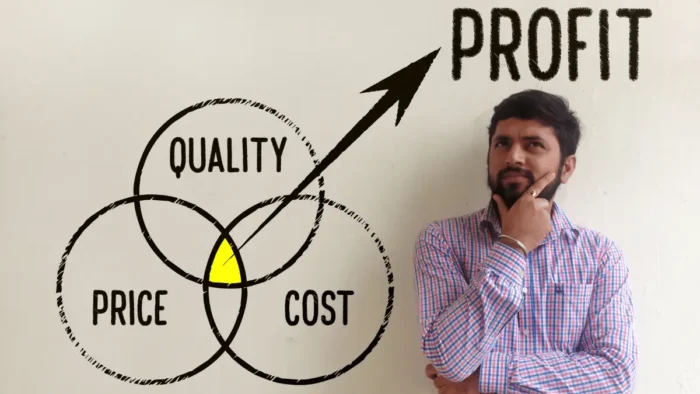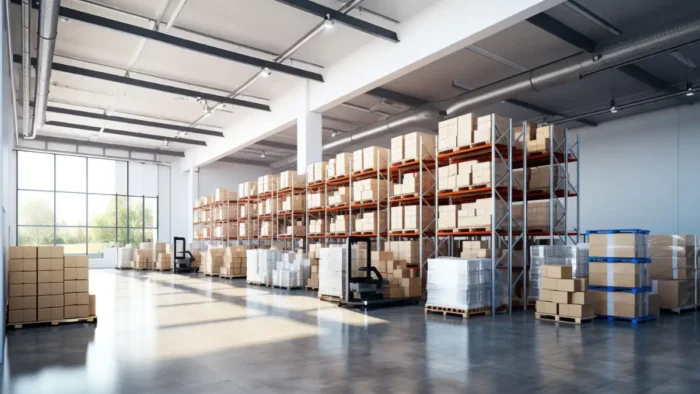Knowing your cost of quality, called quality costs, will help you to ensure that your products meet required quality standards and minimize producing products that fail to meet quality standards.
The goal of calculating the cost of quality is to understand how the quality you produce impacts your company. The cost of quality allows you to analyze and improve the operations responsible for creating value for your customers.
So, here we will explain the quality costs and types of quality costs like failure (internal and external), appraisal, and prevention costs. Also, we will discuss the impact of improvements on costs and how you can measure and calculate quality costs.
The Importance of Quality of Your Products and Services
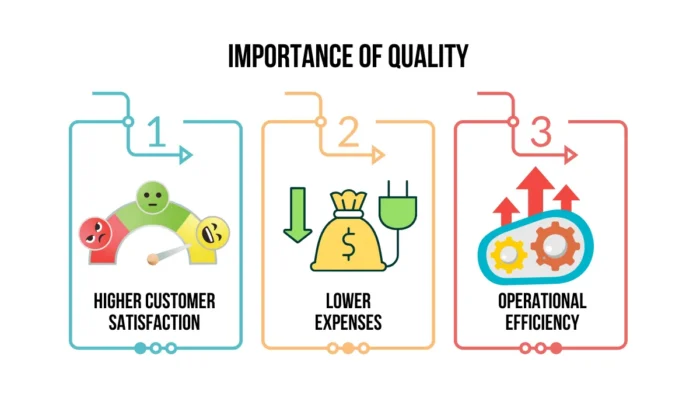
Quality is a critical factor that ensures customer satisfaction, loyalty, and, finally, a company’s success. You already know that today’s customers have high expectations and buy only products and services that meet or exceed their needs.
Let’s discuss why this is important.
- Higher customer satisfaction. Exceptional quality leads to higher customer satisfaction and helps build a strong brand reputation.
- Better quality reduces expenses related to poor or low quality. By investing in prevention measures and conducting detailed appraisals, you can identify and address potential issues before they escalate.
- You will achieve better operational efficiency. When products and services consistently meet quality standards, there will be less need for rework, repairs, customer support, or expensive lawsuits.
Why You Must Implement Cost of Quality (CoQ)?
The quality of the products or services that your company offers to customers will significantly impact several aspects of your business’s operation, which can be converted into monetary value.
Let’s look at how it impacts your profitability.
Losing Customers
One of the most common impacts is the possibility of losing customers. Inadequate design, defective products, poor performance, or weaknesses in some other attribute can hurt your company first by losing customers and low revenue.
If you think you will save some money with poor quality, you will still lose much more. But lost customers are not the only problem. Low quality will convey a bad image and give the customers a wrong perception of your company. This means a long-term loss. The result is a constant decrease in market share and increased criticism from the public, which leads to a truly hopeless situation.
Remember, the cost of non-conformance, or money you must spend when you fail to ensure the required quality of your products and services, will always rise if you don’t take some measure to minimize poor quality.
Legal Aspects of Poor Quality
On the other hand, every organization is responsible for ensuring a certain level of quality according to laws for customer protection in many countries for any company that participates in the market. The responsibility also applies to producing damage or injuries to customers that result from the poor quality of the product or service.
What if you are a manufacturer of equipment that you are selling to a customer who will use it to satisfy their customers, and it does not meet basic quality standards?
For example, late delivery of that equipment will mean later use by the customer and loss of money because your customer cannot meet the expectations of its customers. A longer-term failure of that equipment will again lead to a loss of money for your customer. Inadequate safety standards can injure an employee at the company purchasing your equipment. This brings monetary expenses and a bad image with long-term consequences for your company if it does not provide adequate quality.
Productivity
Quality and productivity always go hand in hand. What does this mean? Increasing quality also means increasing your company’s productivity.
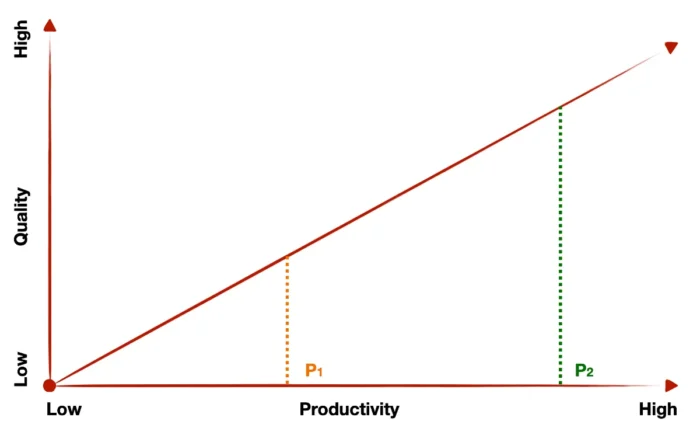
You notice that always with higher quality we will have increased productivity.
Poor quality will negatively affect the productivity of your manufacturing process through the additional time required to process defective units. This means that you will need more production time to produce the same number of units of quality product.
Low-quality supplies will require more control time at inputs and the possibility of using such supplies in the production process, with an entire batch of products being defective and requiring additional processing to achieve the desired quality level.
Also, poor quality will lead to costs incurred during the warranty period, such as repair or replacement of a new product for the customer.
What is the Cost of Quality (CoQ)?
The cost of quality (CoQ) refers to the total expenses incurred by your company to ensure that its products meet quality standards. It contains the expenses associated with preventive costs intended to maintain good quality and the costs incurred due to poor quality because of internal and external failures. Understanding the cost of quality is essential for you if you want to identify areas for improvement and optimize your operations.
The cost of quality includes both tangible and intangible expenses. Tangible expenses are the direct expenses incurred to prevent, appraise, and fix possible issues. They can be easily quantified and measured. On the other hand, intangibles are more challenging to measure as they represent the indirect consequences of poor quality, such as damage to brand reputation, customer dissatisfaction, and lost sales opportunities.
Calculating and analyzing the cost of quality will help you prioritize quality improvement initiatives and allocate resources effectively.
Now, let’s look at the three categories or four types of cost of quality.
Failure Costs
These costs are the result of defective products. Most often, these costs are classified as internal and external failure costs.
Internal failure costs are those discovered during the production of products and services before they are delivered to customers, while external costs are those found after the product or service has been delivered to customers.
Internal Failure Costs
The internal failure costs appear for various reasons, but most often due to defective supplies, inappropriate adjustment of production equipment, defective equipment, improper production processes, errors in the production itself, carelessness of the production staff, and inappropriate storage and maintenance of repro material.
Internal failure costs come because of the following:
- longer production time,
- more waste as a result of defective products,
- rework to repair,
- the need for higher appraisal costs,
- possible damage to equipment and
- potential injury to employees.
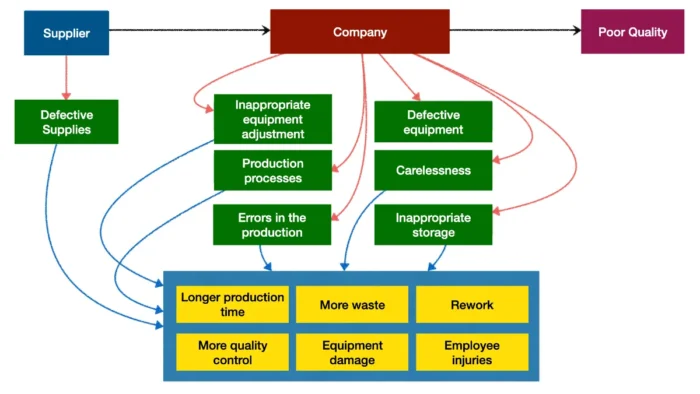
External Failure Costs
External failure costs often occur due to defective parts not detected by the company and have reached customers’ hands. The resulting expenses include warranty claims, warranty work, handling customer complaints, replacement with a new product or product recalls, fines and court fees, and losing customers.
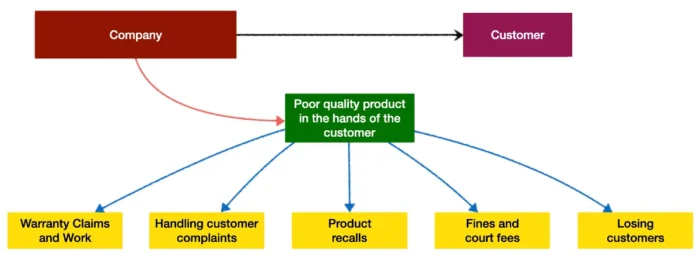
Appraisal Costs
Today, companies cannot afford the luxury of delivering products with inadequate quality because when the customer discovers those defective products, the expenses can increase dramatically and exceed those of internal failures. For this purpose, you must invest money in appraisal to prevent defective pieces from reaching customers.
So, in this case, expenses are intentionally created within the company for appraisal to avoid the external failure costs of defective pieces.
Appraisal costs are specific expenses imposed due to the need to control products, test, and monitor the process to detect defective products or ensure such defective parts do not occur. Possible expenses may be quality control, testing, test equipment, depreciation of test equipment, laboratories, and quality control.
Prevention Costs
The external failure costs can be eliminated through appraisal costs, while you attempt to reduce or eliminate the internal failure costs through prevention.
Prevention costs are those that occur due to the company’s efforts to prevent the occurrence of defective pieces in the production process. These preventive costs can be in the form of quality planning, systems management, joint work with suppliers, employee training, control procedures, and additional efforts in the design and manufacturing stages to reduce the likelihood of failures.
How to Calculate Cost of Quality (CoQ)
The sum of all these costs, internal and external failures, prevention, and appraisal costs, represents the total cost of quality:
Cost of Quality = Failure Costs + Appraisal Costs + Prevention Costs, or
Cost of Quality = Internal Failure Costs + External Failure Costs + Appraisal Costs + Prevention Costs
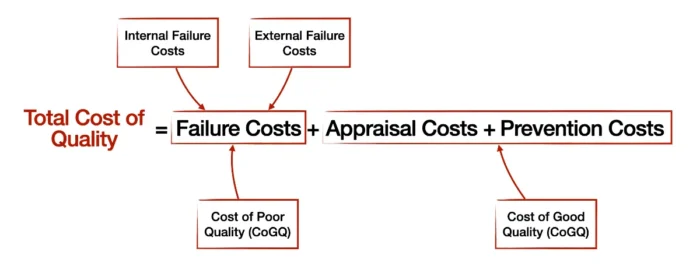
As you can see, you must track both the cost of good quality (CoGQ) and the cost of poor quality (CoPQ) if you want to calculate the total cost of quality.
The Cost of Poor vs. Good Quality
Cost of Good Quality (CoGQ) is incurred when you prevent the loss of quality because of not conforming to specifications.
As we have already said, you can implement various appraisal processes and defect prevention tactics to increase the level of product quality. In this way, you will increase the cost of good quality. It is logical because as you improve the level of quality, the appraisal costs and the prevention quality costs will also increase. You can see in the figure below how the CoGQ (appraisal quality costs and prevention cost) curve grows exponentially as the quality level increases. So, ensuring higher quality means higher costs of good quality.
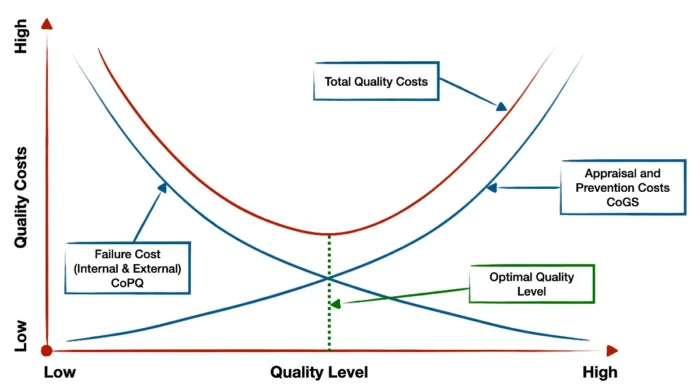
On the other hand, the failure costs are Costs of Poor Quality (CoPQ). They are also related to the level of quality but inversely from the appraisal and prevention quality costs. While the growth of appraisal and prevention cost of quality increases the level of quality, the growth of the failure cost of quality means a lower quality level. This curve declines exponentially as the quality level increases.
A sum of these two curves represents total quality costs. The lowest level of this curve is the optimal level. What does the optimal quality level mean? An optimal level is the highest possible quality level that simultaneously provides the lowest possible total cost of quality.
Dynamic Concept of Cost of Quality
This approach of considering the optimal level is based on a static concept because it simply does not contain the concept of continuous improvement because with such an improvement, not only a reduction in the individual cost of the product or service is obtained, but also a change in the shape of the cost of good quality curve. Typically, the rate of increase of these costs with increasing quality levels will be lower. This second CoGQ curve and the total cost curve are added to the figure. You notice that the optimal quality level increases immediately.
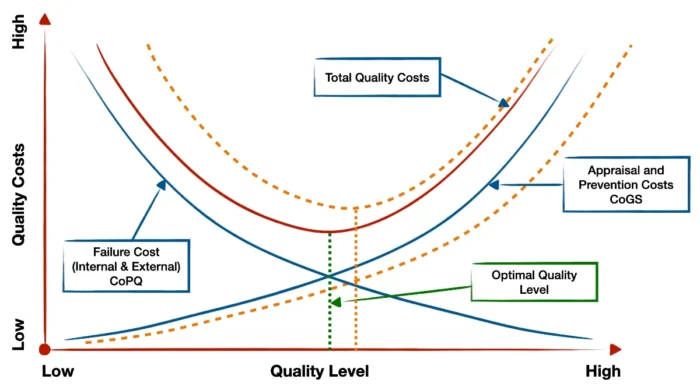
These improvements usually start with incremental improvements over small periods and then progress to drastic improvements to maintain the quality levels you want to achieve.
Causes of Cost of Quality (CoQ)
Quality-related costs result from both chronic problems and occasional quality problems.
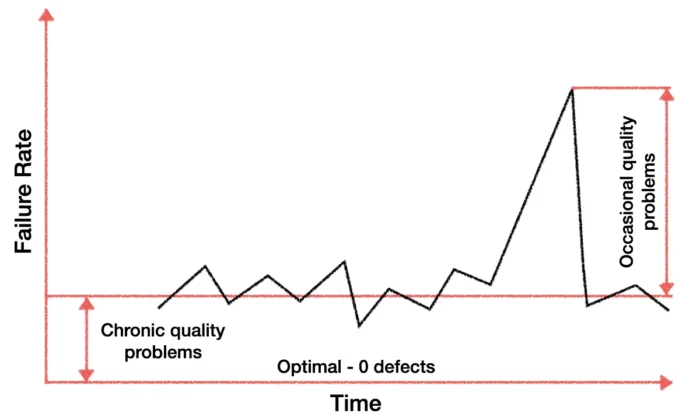
Chronic quality problems are persistent in nature and constant over a longer period. You must reduce or completely eliminate them to achieve the optimal level of defective products, which is defect-free production.
Conversely, occasional quality problems are isolated cases that occur infrequently but result in more defective products. These problems require quick resolution to restore the system to its original state. An example of such a problem could be damage to a production equipment tool.
So, the question is, why do you come to these quality problems? Here are the most common reasons:
1. Lack of appropriate quality management system
You must ensure you have a management system for maintaining product quality standards. You must have quality objectives, quality planning, and implementation systems that will allow you to measure and calculate the cost of quality to work on improvements.
2. Inadequate employee training
Inadequate training can result in errors, defects, and poor quality. When you don’t equip your employees with the necessary skills to perform their jobs effectively, the chances of issues will increase, leading to a higher cost of quality.
3. Inefficient supplier management
Poor quality from suppliers can significantly impact your products or services. If suppliers don’t meet quality standards and deliver materials or components as you require, it can increase the cost of quality associated with rework or product failures.
4. Lack of preventive measures
If you don’t invest in preventive measures, you will likely experience issues. Without proactive measures such as quality planning, process controls, preventive maintenance, and regular quality audits, the risk of defects and errors increases, leading to higher costs.
5. Poor quality control processes
If you don’t have robust control processes, you may need help identifying and addressing possible issues during production or service delivery. This can result in higher costs associated with rework, scrap, warranty claims, and customer complaints.
Conclusion
Understanding the cost of quality is essential if you want to evaluate the impact of quality on your company’s bottom line. By calculating the cost of quality, you can gain helpful insights into areas that require improvement and allocate resources effectively. The cost of quality contains both the expenses associated with maintaining good quality and the costs incurred because of low quality.
Measuring the cost of quality involves considering prevention, appraisal, internal failure, and external failure costs.

